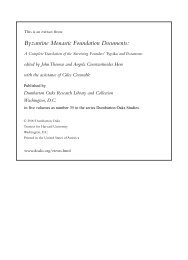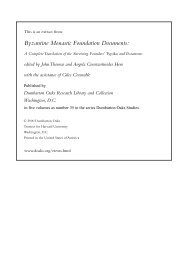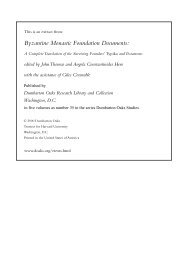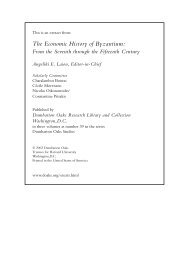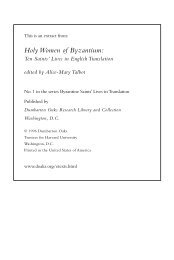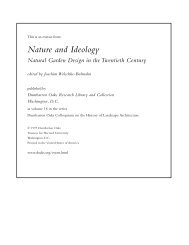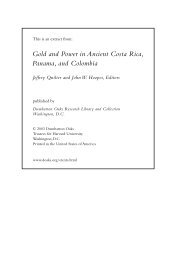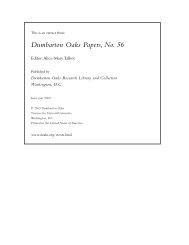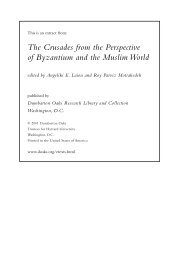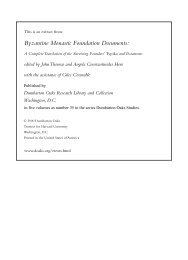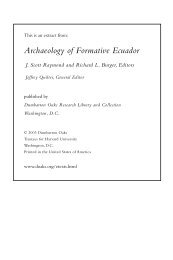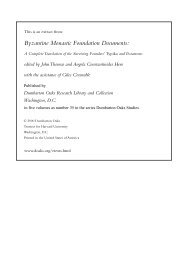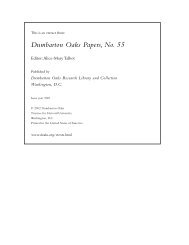22. Evergetis - Dumbarton Oaks
22. Evergetis - Dumbarton Oaks
22. Evergetis - Dumbarton Oaks
You also want an ePaper? Increase the reach of your titles
YUMPU automatically turns print PDFs into web optimized ePapers that Google loves.
ELEVENTH CENTURY<br />
wiping out the distinctions of rank observed in (9) Galesios [130] and endorsing (3) Theodore<br />
Studites [12].<br />
7. Servants Not Permitted<br />
In accord with (3) Theodore Studites [4] but unlike (19) Attaleiates [42], Evergetian monks were<br />
not allowed [24] to have servants.<br />
8. Diet<br />
Fasts and vigils were to be regulated [8] principally by the synaxarion, that is, the liturgical typikon.<br />
The second part of that document contains detailed prescriptions for the dietary regime for the<br />
Lent and the other fasts of the ecclesiastical year. However, there is a considerable amount of<br />
dietary regulation [10] for fasts in the founder’s typikon as well. Generally, (22) <strong>Evergetis</strong> prescribes<br />
more leniently than the somewhat earlier (20) Black Mountain and certainly the later (43)<br />
Kasoulon. Overall, reform monasteries of the twelfth century followed <strong>Evergetis</strong>’ example of<br />
relative leniency, especially the imperial foundations represented by (27) Kecharitomene and (28)<br />
Pantokrator, though (30) Phoberos, usually a close copier of (22) <strong>Evergetis</strong> in most matters, is<br />
stricter in many dietary provisions.<br />
9. Bathing<br />
Perhaps as a bow to an increasing concern with providing for the needs of sick and elderly monks,<br />
a bath is provided [28] in the monastery. As originally written, the relevant passage of the typikon<br />
allowed only the sick to use it, but it appears that this was changed later to permit healthy monks<br />
to bathe three times a year and at the discretion of the superior. This is the first bathing facility to<br />
be attested in the monastic foundation documents.<br />
10. Care of Sick Monks<br />
A cell provided with eight beds and staffed by two orderlies was to be set aside [41] as an infirmary<br />
for monks who might fall sick. If a doctor was available, he was to call on the brothers daily.<br />
11. Burial<br />
Unlike some later documents, e.g., (27) Kecharitomene [70], there are no elaborate provisions for<br />
the burial of the foundation’s monks, but a priest is assigned [36] to take care of burials, and the<br />
departed were to be commemorated liturgically.<br />
B. Constitutional Matters<br />
1. Independent and Self-Governing Status<br />
The typikon revives [12] (without attribution) the concept of the free (eleuthera), independent<br />
(autodespotos), and self-governing (idiodespotos) monastery first seen in (13) Ath. Typikon [12],<br />
thereby establishing a model and new standard of institutional autonomy for generations of founders<br />
to come. 32 This status is said to have dated from the period of <strong>Evergetis</strong>’ foundation, guaranteed<br />
by chrysobulls of “emperors of everlasting memory,” presumably including Constantine IX<br />
Monomachos, otherwise known as a protector of certain monasteries. 33 <strong>Evergetis</strong>’ independent<br />
status was held to make it exempt from subordination to any individual, public or private, and, by<br />
implication, from participation in the charistike.<br />
[ 460 ]




